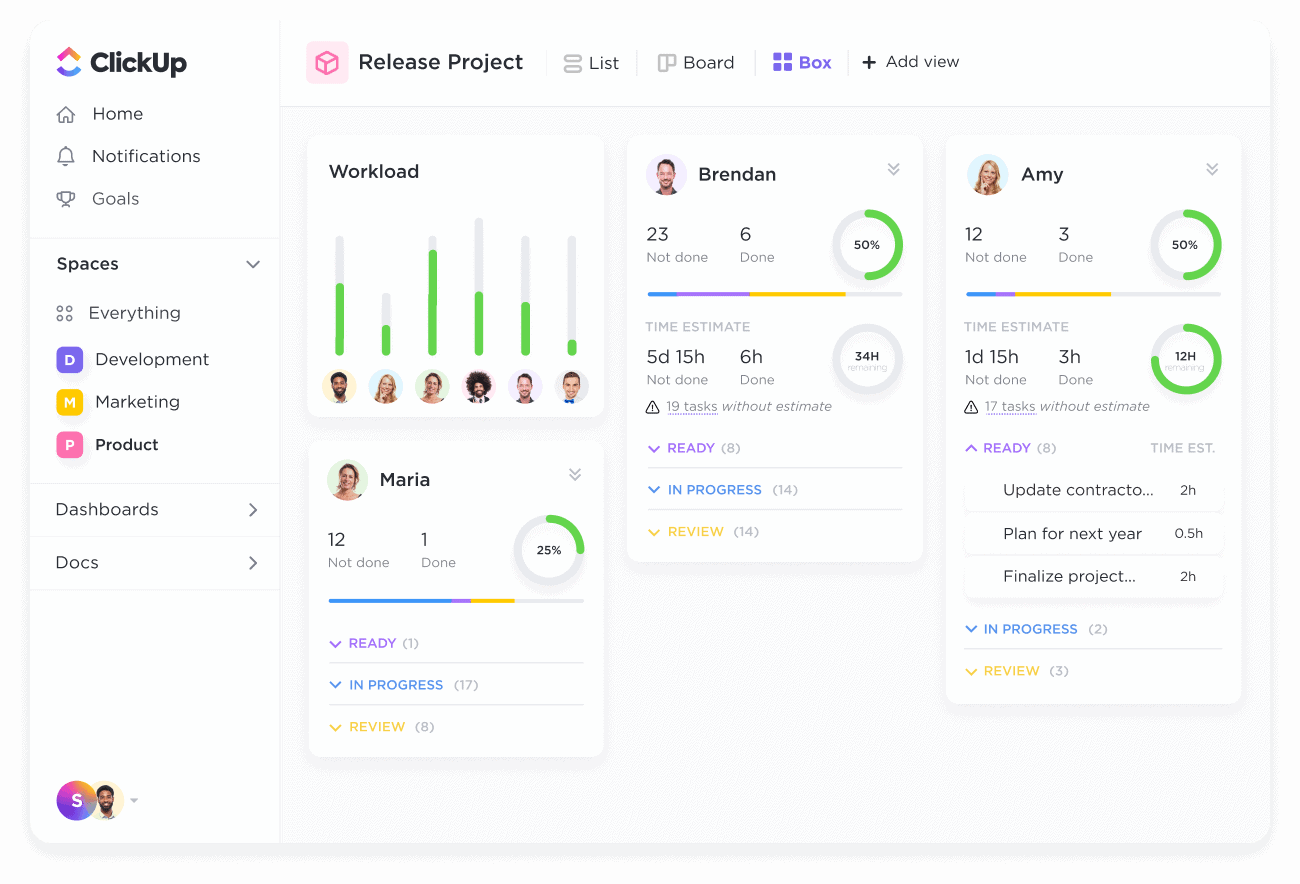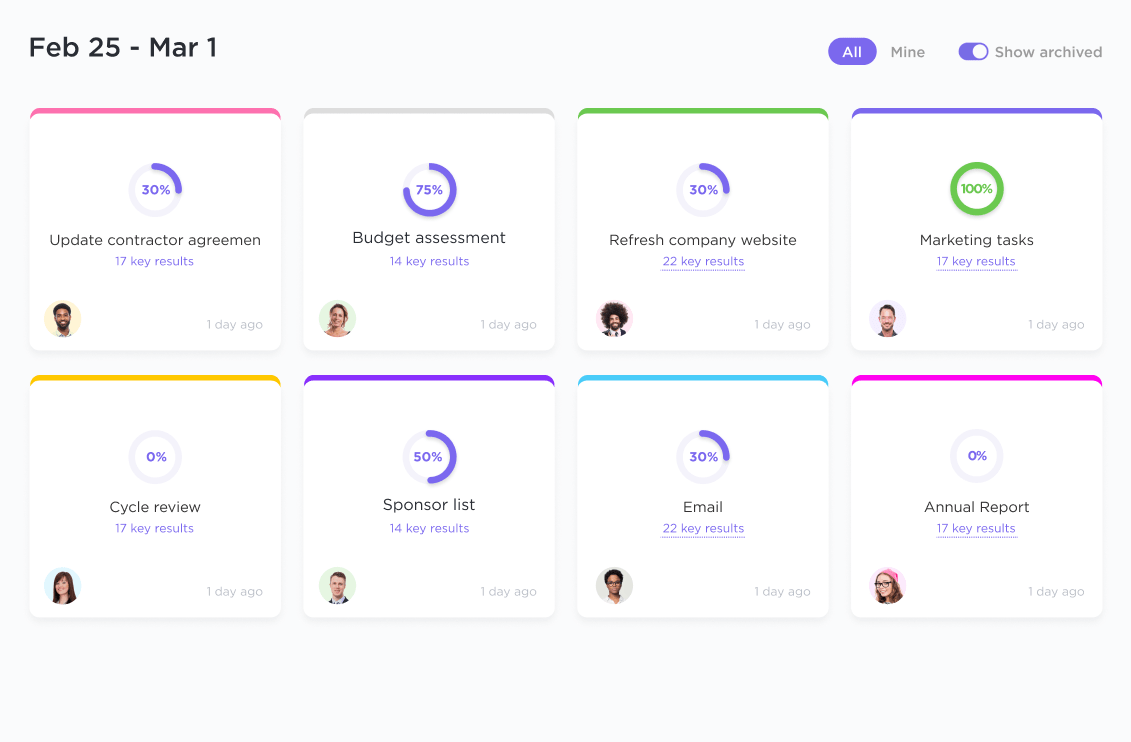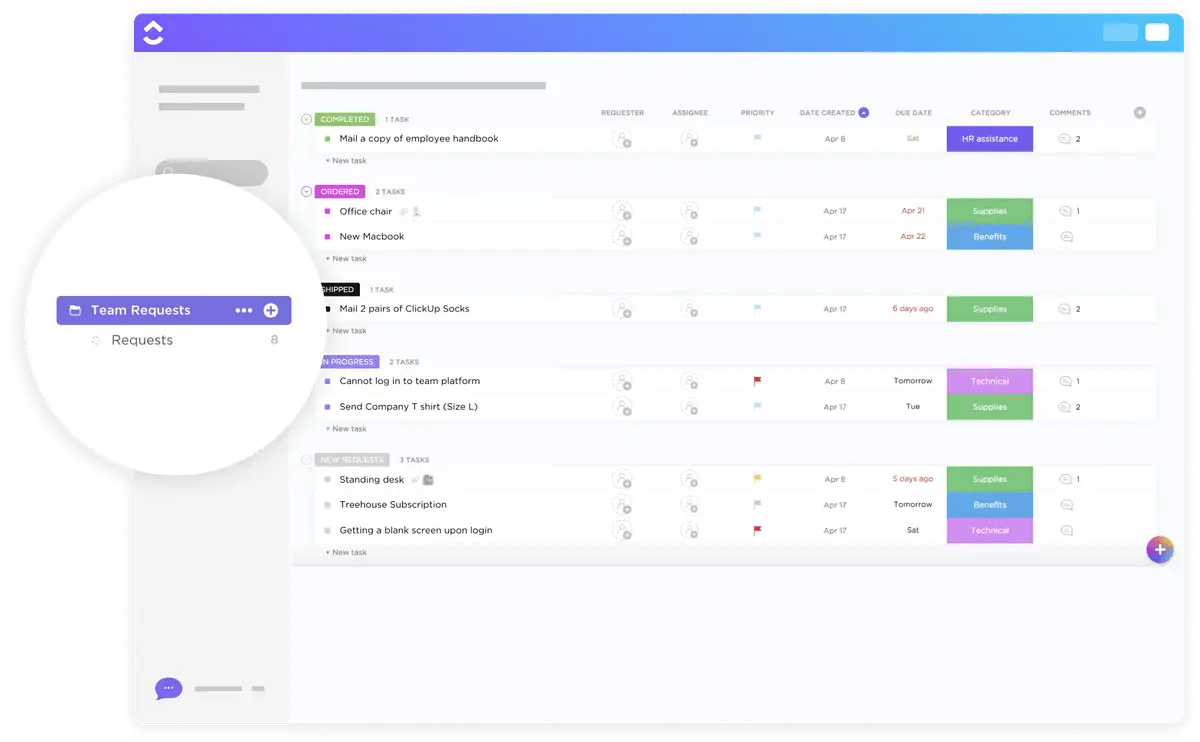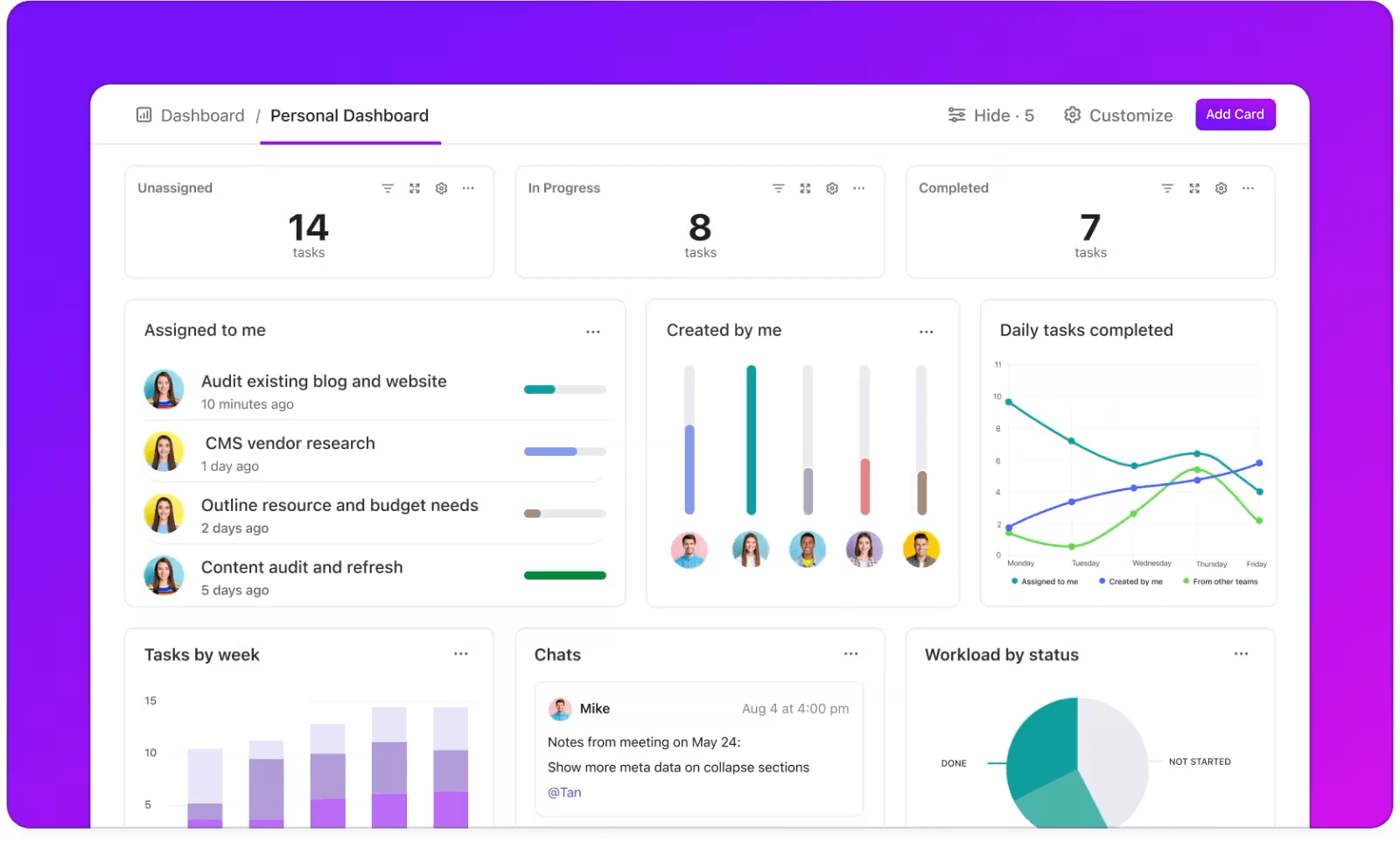لقد قطعت أقسام الموارد البشرية والموظفين شوطاً طويلاً منذ أن وضعها توبي فليندرسون على الخريطة في المسلسل المفضل لدى الجميع "المكتب".
ولنكن صادقين، من المرجح أن يكون الأشخاص المفضلون لديك للتحدث معهم في حفلات الأعياد هم على الأرجح تحت مظلة عمليات الأفراد في شركتك. وهذا على الأرجح لأن قسمي الموارد البشرية والموظفين في شركتك مخصصان لرعاية كل موظف ومسؤولان عن إدارة دورة حياته المهنية.
في الجوهر: ذلك لأنهم يهتمون.
لهذا السبب يمكنك دائماً الاعتماد على مديري الموارد البشرية لتذكر اسمك، وسؤالك عن أحوالك، والاستماع إلى مخاوفك بنشاط.
ولكن لا يزال هناك الكثير من الأمور الأخرى التي تدخل في إنشاء قسم الموارد البشرية ، ووضع أهداف الموارد البشرية الذكية والقابلة للقياس (SMART) هي جزء رئيسي من هذا اللغز.
تعال معنا بينما نتعمق في 12 هدفاً من أهداف الموارد البشرية المفضلة لدينا لكل شركة، بما في ذلك فوائدها وآراء الخبراء والأدوات المفيدة والأمثلة الذكية التي يمكنك العمل عليها اليوم.
ما هي أهداف الموارد البشرية؟
الموارد البشرية - أو ما يمكن أن تسميه عمليات الأفراد - هي الصمغ الذي يربط الأعمال بصمت.
بينما تقوم الأقسام الأخرى بالتخطيط والإنتاج والإطلاق والتسويق لمنتج الشركة، تضمن الموارد البشرية أن يشعر الأشخاص الذين يشكلون تلك الأقسام بالرضا في العمل.
تساعد أهداف الموارد البشرية في منح المديرين وقادة الأعمال إحساساً بالتوجيه عندما يتعلق الأمر بتحسين تجربة الموظفين طوال فترة عملهم. ومثل جميع أهداف شركتك، فإن أفضل أهداف الموارد البشرية هي هي أهداف ذكية :
S: محدد
M: قابل للقياس
A: قابل للتحقيق
R: ذات صلة
T: محددة زمنياً
ربما كان مصطلح الموارد البشرية في السابق مرادفًا للأعمال الورقية والسياسات والكتيبات الإرشادية، ولكن في الواقع، يحمل هذا المصطلح وزنًا أكبر - مع التركيز على الثقافة والسلامة والشمولية ونمو الموظفين.
وهذا يترك مجالاً للإبداع، بل ونجرؤ على القول، المتعة عندما يتعلق الأمر بالتخطيط لأهداف الموارد البشرية للربع القادم. ولكن هذا يعني أيضًا أنه يجب عليك بذل المزيد من الجهد والتفكير بعناية أكبر في وضع أهداف مقصودة سيكون لها تأثير واضح وقابل للقياس على تجربة عمل الموظف.
كما يجب أن تتماشى أهداف الموارد البشرية بشكل مباشر مع المبادئ التأسيسية لشركتك، وأن تعزز بيئة عمل صحية، وأن يتم وضعها مع وضع موظفيك في الاعتبار!
لا داعي للقلق! نحن هنا لمساعدتك في وضع وتحقيق أهداف الموارد البشرية التي طالما حلمت بها - وسيشكرك موظفوك على ذلك.
فوائد وضع أهداف الموارد البشرية لفريقك؟
بغض النظر عن مجال عملك أو حجم شركتك أو ميزانيتك، يجب أن تتمحور أهداف الموارد البشرية حول النمو - سواء لموظفيك على المستوى الشخصي أو للشركة ككل.
في جميع الأقسام، فإن وضع أهداف SMART يجمع الناس معًا، ويضع أعضاء الفريق تحت المساءلة، ويزرع بذور عادات عمل إيجابية وأكثر إنتاجية.
لماذا يجب أن تضع أهدافاً ذكية للموارد البشرية؟
- لمواءمة تركيز فريقك مع القيم العامة للشركة
- لتحسين التجربة الفريدة لكل موظف
- لإعطاء الموظفين شعوراً بملكية عملهم
- لرفع الروح المعنوية
- لقياسالتقدم ومؤشرات الأداء الرئيسية من ربع سنوي إلى ربع سنوي
- لإظهار اهتمامك للناس
_وغير ذلك الكثير
ليس لديك شيء لتخسره وكل شيء لتكسبه من وضع أهداف مدروسة يمكن لقسم الموارد البشرية لديك البدء في تنفيذها في أسرع وقت ممكن اليوم.
بالإضافة إلى ذلك، ليس من الضروري أن تكون بهذه الضخامة! فبدلاً من التركيز على كيفية إحداث ثورة في بيئة العمل في شركتك بين عشية وضحاها، فكّر في التغييرات الصغيرة التي ستحدث تأثيراً كبيراً وستؤدي في النهاية إلى تحقيق نتائج مع مرور الوقت.
12 هدفاً للموارد البشرية يجب أن تضعها كل شركة
قد يبدو أن الكثير من أهداف الموارد البشرية هذه تشترك في فوائد متشابهة عندما يتم تنفيذها بفعالية، وهذا أمر مقصود تماماً.
قد تجد أيضًا أن قسم الموارد البشرية لديك يتبنى بالفعل جزءًا صغيرًا أو أكثر من هذه الأهداف الأكبر. ستوفر لك هذه القائمة طرقاً جديدة لتعزيز آثار تلك الجهود بطريقة أكثر تحديداً لتلبية الاحتياجات المهنية لموظفيك.
استخدم هذه الأهداف الـ 12 للموارد البشرية الذكية الـ 12 لاكتساب وجهات نظر وأفكار جديدة وتحسين شركتك بالموارد التي لديك بالفعل!
_وهل ذكرنا أنه ستكون هناك نماذج؟ هيا بنا!
1. إنشاء ثقافة تتمحور حول الموظف
هل سمعت من قبل عبارة "_أحب عملك ولن تعمل يومًا واحدًا في حياتك؟
إن استثمار الوقت في خلق بيئة عمل إيجابية تركز على الموظف أولاً هو الخطوة الأولى في الوصول إلى هدف الموارد البشرية هذا - وهو أمر مهم للغاية لأنه بقدر ما يبدو الأمر مبتذلًا، فإننا جميعًا نسعى جاهدين لتحقيق ذلك. ⬆️
عندما نتحدث عن ثقافة الشركة، فنحن لا نتحدث عن طاولات البينج بونج داخل المكتب، أو حفرة الذرة، أو المشروبات الباردة في الحنفية - نحن نتحدث عن المؤسسات التي تقدر نفس الأفكار والتوازن بين العمل والحياة والفلسفات التي تقدرها أنت.
وإلى جانب ذلك، فإن موظفيك هم كل شيء! إن وضع موظفيك في المقام الأول يُظهر أنك تهتم بهم وتحترمهم كبشر لديهم حياة واهتمامات والتزامات حقيقية - وليس فقط كقوة عاملة.
_هل تحتاج إلى سبب آخر لإعادة التفكير في ثقافة شركتك؟
إن وضع سياسات ومبادئ توجيهية لحماية سلامة موظفيك وصحتهم النفسية والتوازن بين العمل والحياة الشخصية لموظفيك سيساعدهم على تطوير علاقات مهنية أكثر صحة مع أنفسهم ومع أقرانهم.
ومن وجهة نظر مدير الموارد البشرية، فإن تطوير ثقافة تتمحور حول الموظف سيأخذك إلى أبعد من ذلك, جذب مواهب أفضل وتساعدك على بناء شركة مليئة بالأشخاص المتفانين الذين يسعدهم الحضور إلى العمل كل صباح.
يجب أن يكون أحد أهداف الموارد البشرية في أي مؤسسة هو إنشاء مكان عمل يركز على الموظف. يجسد مكان العمل هذا ثقافة الاحترام والثقة بين الموظفين. عندما يكون هناك احترام وثقة، يمكن أن يشعر الموظفون بالراحة في مشاركة أفكارهم وآرائهم. وهذا سيساعدهم على الشعور بالرضا عن وظائفهم ويجعلهم أكثر إنتاجية. بالإضافة إلى ذلك، يجب أن يكون هدف أي قسم للموارد البشرية هو خلق مكان عمل آمن لجميع الموظفين. فإلى جانب السياسات الواضحة جدًا لحماية الموظفين من المخاطر والإصابات الأخرى، يجب أن يشعر الموظفون أيضًا بالأمان النفسي والعاطفي من خلال الحماية القوية من التنمر والمضايقات، مثل التعليقات المسيئة أو الاتصال الجسدي غير المرغوب فيه
وأخيرًا، باتباع هذا النمط من التفكير، يجب أن تكون الموارد البشرية أيضًا لتمكين الموظفين على جميع مستويات المؤسسة بحيث يكون لديهم القدرة على اتخاذ القرارات بناءً على احتياجاتهم وتفضيلاتهم الخاصة.
بيتر بريلا، أخصائي تسويق التوعية في مختبر السيرة الذاتية
مثال SMART
قم بإنشاء سياسة جديدة تتمحور حول خلق بيئة عمل إيجابية وقدمها في اجتماعك القادم المقرر على مستوى الشركة أو في اجتماع جميع الموظفين.
قد تقدم هذه السياسة الجديدة مبادئ توجيهية تتعلق باللغة والسلوكيات المتعلقة بالمواضيع الحساسة، أو إدارة النزاعات، أو حتى شيء مثير مثل أيام الجمعة الصيفية.
هل تبحث عن طرق للحفاظ على توافق الفريق خلال اجتماع كل الأيدي؟ لدينا ما يلي قالب اجتماع جميع الأيدي في ClickUp مخصص لهذا الأمر بالذات. أبقِ شركتك على اطلاع دائم بأحدث الإعلانات، وشجّع على التعاون، وحسّن الوضوح أثناء الاجتماعات باستخدام قالب قائمة ما قبل الإنشاء هذا الذي يغطي جميع القواعد الخاصة بك.
نموذج اجتماع ClickUp All Hands Meeting
2. اجعل هدفك وقيمك المهنية واضحة
هدف شركتك القيم الأساسية هي أساس ثقافتها.
وبصفتك مدير موارد بشرية أو مدير أعمال، فأنت تدرك ذلك بالفعل، خاصةً بين الموظفين الجدد.
أنت الآن أكثر عرضة لسماع أسئلة من المرشحين المحتملين تتعلق بالإنجاز والأمان والتقدير والسعادة العامة بين الموظفين الحاليين.
هذه تبدو وكأنها أحلام عالمية نريدها جميعًا ولا يجب أن نتوقعها أبدًا من حياتنا المهنية. لكن الأمر هو أن هذه الأهداف يمكن تحقيقها تمامًا مع المجموعة الصحيحة من القيم الأساسية لجذب المرشحين ذوي التفكير المماثل الذين سيلتزمون بشركتك على المدى الطويل.
بالإضافة إلى ذلك، فإن قيمك الأساسية ليست ثابتة. بل يجب أن تتغير مع نضوج شركتك لمواكبة اتجاهات الصناعة، وهوية العلامة التجارية، والجمهور المستهدف، والنمو، وغير ذلك.
في ClickUp، لدينا القيم الأساسية شهدت نصيبها العادل من التعديلات مع استمرارنا في التطور. فكر آراء قوية، غير متماسكة . 😎
لا يمكنك أن تصبح مستقبل العمل بدون السير مع التيار وتقبل التغيير، هل أنا على حق؟
تتحدث قيمنا الأساسية السبعة الآن عن ClickUp كمنتج بقدر ما تتحدث عن الأشخاص الذين يعملون فيه. تساعد هذه القيم فريق ClickUp بأكمله في ClickUp على امتلاك عملهم، وأن يكونوا قدوة يحتذى بها، وأن يفخروا بما يفعلونه، وأن يستمتعوا ببساطة. والأكثر من ذلك، فهي تقودنا إلى مواهب أكبر، ومعدلات استبقاء أعلى، وفرص لا حصر لها للنمو الداخلي. 🙌🏼
_من الضروري أن يكون هدفك وقيمك المهنية واضحًا وجريئًا ورنانًا. ماذا أعني بذلك؟
_ أن تكون واضحة - مكتوبة بعبارات بسيطة وتوضيحية وبلغة يفهمها ويتذكرها الجميع
_ جريئة - تثير الكلمات شيئًا ما. ربما شيء مختلف قليلاً لدى الجميع، لكن لا أحد لا يتأثر بها. كبشر، لدينا غريزة التجمع في قبائل أو مجتمعات، ولكن هذه لا تستمر إلا عندما يكون هناك معنى وهدف واضح
ليست مجرد كلمات، بل تظهر في كيفية اتخاذ الشركة للقرارات وإدارة الأمور، بما في ذلك وخاصة التوظيف. إذا لم تستطع أن تشير إلى كيفية إرشادهم لاستراتيجيتك وعملياتك ذات الأهمية الحاسمة للمهمة، فأنت لا تسير على نهجها
ناثان ديلي، رئيس قسم الأفراد في نث فينتشر
مثال ذكي
بحلول نهاية الشهر، قم بإنشاء وتقديم قائمة لا تزيد عن سبع قيم أساسية لا تتعدى سبع قيم أساسية ترتبط بها شركتك وموظفيك.
نصائح احترافية:
- أولاً، ألقِ نظرة فاحصة وناقدة على قيم شركتك الحالية
- ابحث عن الإلهام من كتب مثلالحافة الطفيفة,العادات الذرية، أومن الرؤية إلى الواقع
- لا تخف من سؤال رؤساء الأقسام الأخرى والموظفين الحاليين والموظفين الجدد عن الفلسفات التي تحركهم
3. متابعة تقدم الموظفين
بالنسبة إلى كل الوقت الذي يستثمره الموظفون في الشركة، فإنهم يريدون أن يعرفوا أن الشركة مستعدة لاستثمار نفس الجهد في المقابل.
ويعد دمج فرص التعلم في تجربة كل موظف طريقة رائعة للتعبير عن هذا الجهد.
قد يأتي هدف الموارد البشرية هذا في شكل حساب تعليمي على مستوى الشركة على موقع LinkedIn، أو متحدثين شهرياً من داخل الشركة أو خارجها، أو مؤتمرات، أو فرص إرشادية لأي موظف مهتم. إنها أيضاً خطوة في الاتجاه الصحيح عندما يتعلق الأمر بالاحتفاظ بأفضل موظفيك أيضاً!
هذا قالب المسار الوظيفي بواسطة ClickUp هو مورد ممتاز للتعريف بالمسار المهني الشخصي التطلعات المهنية في الأهداف الفصلية لكل موظف. ستحافظ هذه القائمة على أهداف موظفيك منظمة وسهلة الفهم، بغض النظر عن القسم الذي ينتمون إليه.
قالب المسار الوظيفي ClickUp
تنزيل هذا القالب يريد المرشحون أن يعرفوا أنهم ينضمون إلى فريق عمل يشجعهم على متابعة شغفهم - حتى لو لم تكن لديهم الخبرة بعد. وعلى المدى الطويل، سوف يجعل القوى العاملة لديك أقوى وأكثر تنوعًا، وأكثر استباقية.
لا يمكن أن تنجح الشركة إلا إذا نجح الأشخاص داخل الشركة أيضًا وشعروا بأن لديهم فرصة للتقدم أكثر. يجب أن يكون الهدف الرئيسي للموارد البشرية هو ضمان حصول القوى العاملة على التدريب وانخراطها فيه لدفع الأعمال إلى الأمام واكتساب الشعور بالإنجاز الشخصي. تحتاج الأدوار وأنواع الأعمال المختلفة إلى برامج تدريبية مختلفة، ولكن يجب أن تكون الموارد البشرية واثقة من أن البرامج التي تختارها هي الأنسب للمتدربين المعنيين
مورغان تايلور، الرئيس التنفيذي والشريك المؤسس سوركيري
مثال SMART
تنفيذ مركز موارد التعلم في LinkedIn عبر عدة فرق خلال هذا الربع من العام.
4. السعي لتعزيز تجربة الموظفين
لقد تحدثنا كثيراً عن ثقافة الشركة وقيمها وفرص التعلُّم - ولكن تجربة الموظف تمتد إلى أبعد من ذلك.
نعم، تساعد بيئة العمل المناسبة على بناء أفضل المواهب المناسبة، ولكن ماذا عن أجزاء حياتهم العملية التي لا تظهر في قائمة المهام اليومية؟
تبدأ تجربة الموظف من أول تفاعل - حتى قبل أن يتم تعيين المرشح - وتستمر لبقية الوقت الذي يقضيه كعضو في الفريق.
قد يشمل الارتقاء بتجربة الموظف لديك تجديد إعلانات الوظائف الشاغرة لديك، والرد على المرشحين بشكل أسرع, تبسيط عملية تأهيل الموظفين أو حتى تقديم جائزة شهرية جديدة لاجتماعات شركتك.
هذه كلها أمور تساعد الموظفين على الشعور بأنهم مرئيون، ويثقون في أقسام الموارد البشرية، ويقل قلقهم خلال أسبوع العمل. بالإضافة إلى ذلك، فإنها تُظهر للموظفين أن شركتهم تقدر وقتهم وآراءهم وملاحظاتهم - وليس فقط أداءهم.
تحقق من هذه الأمور قوالب مراجعة الأداء !
_الأشخاص هم أهم أصولنا. فتجربتهم ستحدد بالتأكيد مدى التزامهم. من الضروري أن نركز على العملية والبرامج والأنظمة التي تربط وتنمي بشكل مباشر أولئك الذين وافقوا على أن يكونوا جزءًا من مؤسستك
في حين أننا جميعًا قد اختبرنا جميعًا الاستقالة العظيمة، فإن الوحي العظيم هو أننا إذا قمنا بتعزيز ما نقوم به، فسوف نحافظ على من لدينا. فبدءًا من نظام التهيئة إلى نظام التقدير والمكافآت الخاص بك، مرورًا بسياساتك الأساسية والقاعدية المكتوبة في دليل لا يرغب أحد في قراءته، يمكنك تحسين تجربة الموظفين من خلال الاستماع الفعال لما يقولونه وما لا يقولونه واستخدام تلك البيانات لتحديد وتصميم حلول للمشاكل التي تعيق الأداء والهدف والإمكانية. >
خليل الله أولوكونولا، الرئيس التنفيذي لشؤون الموظفين في ألوان TRU
مثال ذكي
قدم طريقة جديدة لتكريم موظفيك بحلول بداية الربع القادم. إذا كانت لديك جائزة قائمة بالفعل، كيف يمكنك تحفيزها وتنشيطها؟
نصائح احترافية:
- استخدم ما تبقى من ربع السنة للتفكير فيما يستلزمه هذا التكريم. هل هناك جائزة؟ كيف يتم تقديمها للشركة؟ ما الذي يجعلها مميزة؟
- اطلب من المديرين ترشيح أعضاء من فريقهم لمساعدة جميع الأعضاء على الشعور بأنهم مرئيون
المكافأة:_
_/مرجع/ مدونة؟ p=56264_ تعرف على نماذج فريق العمل للموظفين الجدد %/%href/_
!
5. التركيز على عمليات الأشخاص
ألم تسمع؟ عمليات الأفراد هي الموارد البشرية الجديدة.
لقد حان الوقت لتغيير العلامة التجارية.
جنباً إلى جنب مع ثقافة العمل المتمحورة حول الموظف، فإن إعادة تركيز أهداف الموارد البشرية على عمليات الأفراد يُظهر أنك ترى القوى العاملة لديك أكثر من مجرد رقم أو آلة.
لكي ينجح قسم الموارد البشرية في إدارة الأفراد يجب أن يركز على "عمليات الأفراد" بدلاً من التركيز على نهج الموارد البشرية التقليدي فقط. إن العمل على تحقيق هدف الملوثات العضوية الثابتة يعني أن الفريق يعمل على تحقيق ثقافة "الأشخاص أولاً"، مع النظر إلى الرفاهية والثقافة والمرونة. تعمل الملوثات العضوية الثابتة على زيادة الاحتفاظ بالموظفين من خلال ضمان سعادة الموظفين وشعورهم بالإنجاز وأنهم قادرون على رؤية المزيد من التطور، فهم يشعرون بأنهم منخرطون ومقدرون. فهم ليسوا مجرد تروس في عجلة بل يشعر كل فرد منهم بأنه جزء من العمل الأوسع نطاقًا ويشعرون بالرضا من خلال إنجاز العمل الذي يقومون به
تريسي بيفيردج، مديرة الموارد البشرية في شيكات الموظفين
مثال SMART
إنشاء برنامج أو فعالية صحية فصلية للموظفين للمشاركة فيها.
قد تكون هذه الفعالية عبارة عن لحظة ترابط في شكل عمل تطوعي جماعي، أو حصة يوغا عند الطلب لفرق العمل عن بُعد، أو حتى قناة Slack للعافية للموظفين لتشجيع أقرانهم على الاهتمام بالصحة الذاتية من الداخل والخارج.
تتبع الأهداف مع برنامج مراجعة الأداء !
7. ممارسة المرونة التنظيمية
إذا لم تكن قد أنشأت بالفعل بيئة عمل مرنة لموظفيك، فهم على موعد مع متعة حقيقية.
إن جزءًا من تبني التوازن الإيجابي والصحي بين العمل والحياة الشخصية هو الاعتراف بأننا جميعًا نقوم بما هو أكثر بكثير من مهام العمل اليومية.
وعلى الرغم من أن موظفيك قد يحبون المكتب وبيئته ومواقف السيارات وأعضاء فريق العمل، فإن وجود خيار العمل عن بُعد يخفف ضغطاً كبيراً على أولئك الذين لديهم أيضاً أطفال وحيوانات أليفة وأزواج والتزامات في المنزل.
_ أصبح هذا أمرًا حيويًا في عالم ما بعد كوفيد-19. إن وجود قوة عاملة واستراتيجية قابلة للتكيف أمر مهم للغاية. أصبحت سباقات السرعة القصيرة المؤثرة هي القاعدة لصالح الخطط الاستراتيجية متعددة السنوات. لا يزال من المهم وضع الهدف النهائي في الاعتبار، لكن المرونة والقدرة على التكيف للوصول إلى هناك أمر أساسي

ناتاشا والاس، شريك عمليات الأفراد الدولية في ClickUp
ضع في اعتبارك أن الجدول الزمني المرن لا يأتي دائمًا في شكل العمل من المنزل.
فبيئة العمل المرنة يمكن أن تبدو أيضاً كجدول زمني معدّل من 8 إلى 5 ساعات.
خاصةً بالنسبة للبوم الليلي, أعضاء فريق التنوع العصبي والمبدعين، فإن أفضل ما لديهم من عمل وتحفيز قد لا يصيبهم في نفس الوقت كل يوم. A جدول عمل داعم يُظهر لأعضاء الفريق أنهم محل ثقة الموارد البشرية والإدارة.
مثال SMART
وسّع نطاق العمل من المنزل أيام الجمعة أو خيارات العمل المرن أيام الثلاثاء والخميس لجميع الموظفين في بداية الربع القادم.
نصائح احترافية:
سيحتاج قسم تكنولوجيا المعلومات إلى تنبيه كبير إذا كان فريقك يعمل من المنزل في الوقت الحالي. 👀
هذا قالب طلبات الفريق في ClickUp سيساعدك في تخزين جميع طلبات تكنولوجيا المعلومات واحتياجات موظفيك من المعدات والمزايا والمستلزمات في مجلد منظم مع المهام، والحالات المخصصة، وطرق العرض المتعددة لجعل انتقالك من المنزل إلى العمل من المنزل سلسًا قدر الإمكان.
قالب طلبات فريق ClickUp
8. تعلم وتحدث لغة العمليات التجارية
نحن نعلم مدى أهمية معرفة شعور موظفينا تجاه العمل، ولكن ماذا عن العمل الذي يقومون به بالفعل؟
إن هدف الموارد البشرية هذا أقل تركيزًا على الأداء وأكثر تركيزًا على إبراز كيفية تناسب أدوار الموظفين معًا لإضفاء الحيوية على العمل بأكمله.
إن إظهار الاهتمام بمعرفة كيفية عمل الفرق المختلفة، وكيفية عمل الموظفين المختلفين مع الآخرين، والتحديات المشتركة بين الأدوار المختلفة سيقطع شوطاً طويلاً. لن يؤدي ذلك فقط إلى بناء علاقتك مع الموظفين خارج نطاق مرحلة التأهيل ، ولكنها ستساعد الآخرين على الشعور بفهم الموارد البشرية.
"أنت لست الشخص النموذجي للموارد البشرية" هي مقولة سمعتها معظم حياتي المهنية في مجال الموارد البشرية. ما زلت أفاجئ قادة الأعمال وأسعدهم من خلال تعلم لغة عملياتهم واستخدامها في حلولي البرمجية من مجموعة أدواتي. إن وظيفتي هي أن أقوم بالترجمة لفهمهم وليس وظيفتهم أن يتعلموا الموارد البشرية _
جيل هيداجي، رئيس قسم الأفراد في كليرمونت بارتنرز
مثال ذكي
حدد موعدًا لاجتماعات منفصلة مع قادة الفرق في الأقسام المختلفة للتعرف عليهم والاستماع إلى عملياتهم ومعرفة بعض لغاتهم المشتركة بحلول نهاية الشهر.
9. تعزيز مشاركة الموظفين
إن إنشاء عدد كبير من المبادرات الجديدة شيء، ولكن التأكد من حضور الموظفين لها بالفعل شيء آخر تمامًا.
من خلال التعرف على موظفيك وبذل الجهد للتفاعل معهم، سيكون من المرجح أن يتفاعلوا معك بالمثل.
بالإضافة إلى ذلك، فإن كل أهداف الموارد البشرية هذه هي من أجلهم!
هذه الأهداف SMART تخدش فقط سطح الاحتمالات. مفتاح تحقيق أهداف أقوى مشاركة الموظفين هو دعمهم والتعاطف معهم.
_الهدف الوحيد الذي يجب أن يكون لديك في شركتك لكي تكون ناجحًا هو مشاركة الموظفين. ستركز العديد من الشركات على مقاييس التوظيف ومعدل الدوران والاحتفاظ بالموظفين لقياس مدى نجاح استراتيجية إدارة الأفراد. أعتقد أن المقياس الوحيد للإدارة الناجحة للأفراد هو مدى تفاعل موظفيك داخل شركتك
_ كلما زاد تفاعل موظفيك كلما زاد العائد على عملاء الشركة ومبيعاتها وأرباحها. فالقادة الذين يركزون على إشراك الموظفين والتأكد من أنهم يتلقون التحدي والدعم والرعاية سيوفرون أيضًا نفس المستوى من الرعاية والاهتمام لعملاء الشركة أيضًا
_تشير الإحصاءات إلى أنه كلما حسّنت مشاركة الموظفين، يمكنك أن ترى زيادة تصل إلى 17% في إنتاجية الموظفين (ويكهام، 2020) وزيادة تصل إلى 21% في أرباح الشركة (هارتر، 2018). من الواضح جدًا أنه مع تحسين الشركات لمشاركة الموظفين يستفيد الجميع، الموظفون والعميل والشركة
نيل كاتز، المؤسس والرئيس التنفيذي لشركة حلول الموارد البشرية الاستثنائية
مثال ذكي
تناول الغداء في المكتب يومًا واحدًا في الأسبوع. إذا كنت تستطيع، يجب أن تبدأ ذلك في أسرع وقت ممكن. الجميع يحب الطعام ولا يوجد شيء يضاهي الترابط مع الأصدقاء الجدد على وجبة.
10. بناء ثقافة الشركة المتنوعة والمنصفة والشاملة للجميع
يمكن القول إن جميع أهداف الموارد البشرية الخاصة بك تبدأ حقًا من هنا.
يرغب الموظفون في العمل في شركة تعكس وتحتضن العالم الحقيقي، والأهم من ذلك، أنفسهم. تؤدي ثقافة الشركة المتنوعة والشاملة إلى بيئة عمل آمنة، وعلاقات أقوى بين الأقران، وأفكار أفضل بصراحة.
إن وجهات النظر الجديدة هي مفتاح حل المشاكل بطريقة إبداعية وابتكارية والنجاح في نهاية المطاف. ولكن الأهم من ذلك، يساعد التنوع والشمول الموظفين على الشعور بالانتماء.
وهذا أمر في غاية الأهمية لأنه يجعل كل موظف، بغض النظر عن هويته وخبراته السابقة ودوره الوظيفي، يشعر بالتواصل والتقدير على قدم المساواة لما هو عليه في الشركة. إن وجود تنوع في الفكر والمنظور يزيد من رضا الموظفين ويزيد من الابتكار والإنتاجية، ويخلق بيئة أكثر سعادة في جميع المجالات

ناتاشا والاس، شريك عمليات الأفراد الدولية في ClickUp
لا أحد يرغب في أن يشعر بأنه يخفي أجزاء مهمة من نفسه أو حياته عن فريقه، ولا ينبغي أن يفعل ذلك. فالموارد البشرية تتمحور حول الأشخاص، وإعطاء قيمة عالية لخلق بيئة عمل عادلة يُظهر أنك تمتلك هذا الشعور حقاً.
الهدف الأهم في إدارة الأفراد هو أن يكون لديك استراتيجية مؤسسية تبني قوة عاملة متنوعة وشاملة ومنصفة وتعزز ثقافة الانتماء. ويُعدّ برنامج DEIB عاملاً مهمًا في تحقيق النجاح.
أنجيليك هاميلتون، الرئيس التنفيذي والشريك المؤسس لشركة مجموعة HR Chique Group
مثال ذكي
حدد اجتماعًا شهريًا لأي موظف لمشاركة الأفكار والأفكار والاهتمامات المتعلقة بالتنوع والمساواة والشمول داخل شركتك.
نصيحة احترافية: احرص على أن يعرف الموظفون أن بإمكانهم دائمًا التواصل معك شخصيًا بشأن مخاوفهم إذا لم يتمكنوا من الحضور أو إذا كانوا يشعرون بالخوف من بيئة الاجتماعات.
11. خلق بيئة آمنة ومأمونة للموظفين
يجب أن يكون العمل دائمًا مكانًا آمنًا ومأمونًا لجميع الموظفين من الناحيتين النفسية والجسدية.
لا يتعلق هذا الأمر فقط بكيفية تعامل الموظفين مع بعضهم البعض، ولكن بمدى ارتياحهم لطلب المساعدة، والإبلاغ عن المواقف غير المريحة، والتعبير عن آرائهم ببساطة.
نعم، تساعد بيئات العمل المرنة الموظفين على الشعور بمزيد من الأمان والراحة حيث يمكنهم اختيار مواقع العمل الخاصة بهم، ولكن لا ينبغي أن يكون ذلك هو الخيار المفضل عند ظهور أول علامات التسمم أو الإرهاق أو عدم الثقة بين فرق العمل.
الهدف الأول لدي في شركتي هو أن أكون قادرًا على تعزيز بيئة عمل يشعر فيها الموظفون بالأمان والراحة. نريد لموظفينا أن يثقوا بمشرفيهم، ونريدهم أن يشعروا بالراحة في طلب المساعدة عندما يحتاجون إليها. وأود أيضًا أن يعرف أعضاء فريقي أنني متاح على مدار الساعة طوال أيام الأسبوع للإجابة عن أي أسئلة أو استفسارات قد تكون لديهم
_ هناك طريقة رائعة لتحقيق ذلك من خلال نظام تواصل يسمح لي بالتواصل بسهولة مع كل موظف على طريقة الاتصال المفضلة لديه (مثل الهاتف، البريد الإلكتروني، الرسائل النصية). وبصفتي قائدًا لهذه المؤسسة، فأنا مسؤول عن تحديد النغمة والثقافة داخل فريقنا بالإضافة إلى توفير التوجيه عند الحاجة لكي ننجح جميعًا معًا
أندرو كوسينز، مالك ومدير فيلم فولك
مثال ذكي
تواصل مع الموظفين بحلول نهاية الأسبوع لتحديد تفضيلات العمل والتواصل الخاصة بهم حتى يعرفوا أنك تحترم وتتفهم حدودهم الفردية.
12. إعطاء الأولوية للتغذية الراجعة من كل زاوية
عندما تقول الموارد البشرية "نريد أن نسمع منك!" فنحن نعني ذلك.
تعد نماذج الملاحظات الرقمية طريقة مريحة وسريعة لجمع ملاحظات العملاء _والملاحظات الداخلية.
نموذج ملاحظات قابل للتخصيص مثل قالب نموذج الملاحظات الخاص ب ClickUp لن يساعدك فقط على جمع الملاحظات بشكل أسرع، بل سيخفف عنك بعض الضغط الناتج عن فرزها من خلال إضافتها تلقائيًا إلى قائمة مصنفة مع خيارات عرض متعددة، وحقول مخصصة، وحالات مخصصة.
قالب نموذج التغذية الراجعة الخاص بـ ClickUp
تنزيل هذا القالب يجب أن تكون التغذية الراجعة أمرًا يوميًا ومتوقعًا بعد أي تفاعل. فالتغذية الراجعة المباشرة والصادقة واللطيفة هي مفتاح الابتكار وستؤدي في نهاية المطاف إلى اجتماعات ومحادثات وجودة عمل أكثر إنتاجية في جميع المجالات.
_التطوير المهني الذي يتمحور حول السلامة النفسية والتعاطف والصراحة الجذرية هي بعض المبادرات المهمة التي عززت مشاركة الموظفين بشكل كبير في ClickUp. عندما يشعر الموظفون حقًا أنهم جزء من شيء أكبر من أنفسهم، ينعكس ذلك داخل الشركة. وعندما يشعرون أن أفكارهم وأفكارهم وملاحظاتهم تحظى بالتقدير، فإنهم يحرصون على تقديم الحلول. عندما يدرك جميع الأشخاص بغض النظر عن دورهم أنهم يساهمون في السلامة النفسية للمؤسسة، فإن جميع الأشخاص يعملون بجد للحفاظ عليها

ماندي مخايل، مديرة التمكين الداخلي في ClickUp
يتم تعيين كل عضو من أعضاء الفريق لمزيج فريد من المهارات والخبرات التي تجعل الشركة بأكملها أقوى.
لا توجد شركة متوقفة عن قصد، ولكن أفضل طريقة للبدء في الخروج من الروتين هي اللجوء إلى فريقك للحصول على تعليقاتهم.
_ في معظم الأحيان، يكون التركيز الأساسي لبرامج التغذية الراجعة أو المراجعة هو تقييم الأداء الفردي من قبل المديرين مع مدخلات محدودة من الأقران أو غيرهم. وهذا الهيكل يحد من أداء الفريق ويعيق التوافق والتقدم نحو الأهداف التنظيمية
إن المنظمة التي تخلق بيئة تكون فيها التغذية الراجعة - سواء كانت بناءة أو للتهنئة - متوقعة ومفعلة للأفراد على كل مستوى تبني الثقة وتزيد من احتمالية الأداء الفردي القوي والمشاركة بالإضافة إلى تحقيق أهداف العمل
كيندرا هابركورن، رئيس قسم المواهب في رينج فنتشرز
مثال ذكي
تأكد من أن الموظفين يعلمون أن التغذية الراجعة متوقعة ومهمة لشركتك من خلال مجموعة من الإرشادات حول كيفية تقديم التغذية الراجعة.
اطلب من الموظفين كتابة ومشاركة مستندات "اعمل معي" بحلول نهاية الأسبوع مع أسلوب التواصل والتغذية الراجعة المفضلة لديهم للحفاظ على تجربة التغذية الراجعة صادقة وإيجابية وشخصية.
كيفية تتبّع أهداف الموارد البشرية لفريقك
مرحى! لديك 12 هدفًا ذكيًا وذكيًا يركز على الأشخاص أولًا لتقدمها لأقسام الموارد البشرية لديك وسيشعر موظفوك بالفوائد في أي وقت من الأوقات.
حتى بالنسبة لما يبدو وكأنه أصغر التعديلات، فإن وجود برنامج قوي لإدارة العمل لتنظيم فرقك وأهدافك ومؤشرات الأداء الرئيسية أمر ضروري لتعزيز الإيجابية حول المبادرات الجديدة.
هكذا يرفع ClickUp العبء عن كاهل فريق الموارد البشرية لديك. ClickUp هو برنامج الإنتاجية الشامل والمتكامل لإنشاء أهدافك وتتبعها وتحقيقها على نفس المنصة التي تدير مهام عملك الأخرى بالفعل.

تصوّر ما يعمل عليه فريقك وما أنجزه باستخدام طريقة عرض Box في ClickUp
تم تصميم تجربة ClickUp الغنية بالميزات لتعزيز الإنتاجية في جميع الأقسام، بما في ذلك ميزة أهداف ClickUp لرصد التقدم المحرز مع الأهداف العددية والنقدية والصحيحة أو الخاطئة والأهداف السريعة.
لوحة معلومات ClickUp
احتفظ بجميع أهداف الموارد البشرية الخاصة بك معًا في مجلدات أهداف منظمة وقم بتحرير الأذونات بسهولة للتحكم في من يمكنه الوصول إلى الأهداف المختلفة - مثالي لوضع الأهداف الشخصية والموجهة للفريق.
بالإضافة إلى ميزة الأهداف القابلة للتخصيص، يوفر ClickUp أيضًا مكتبة لا حصر لها من الأهداف المجانية المبنية مسبقًا قوالب الموارد البشرية والتوظيف لمساعدتك على التصرف بناءً على الأفكار الجديدة في اللحظة التي تراودك فيها.
لا تنام على أهداف الموارد البشرية الخاصة بك للحظة أخرى, اشترك في ClickUp مجانًا للبدء في إعادة تركيز عملياتك على الأشخاص الذين يقودون نجاح الشركة. 💜






